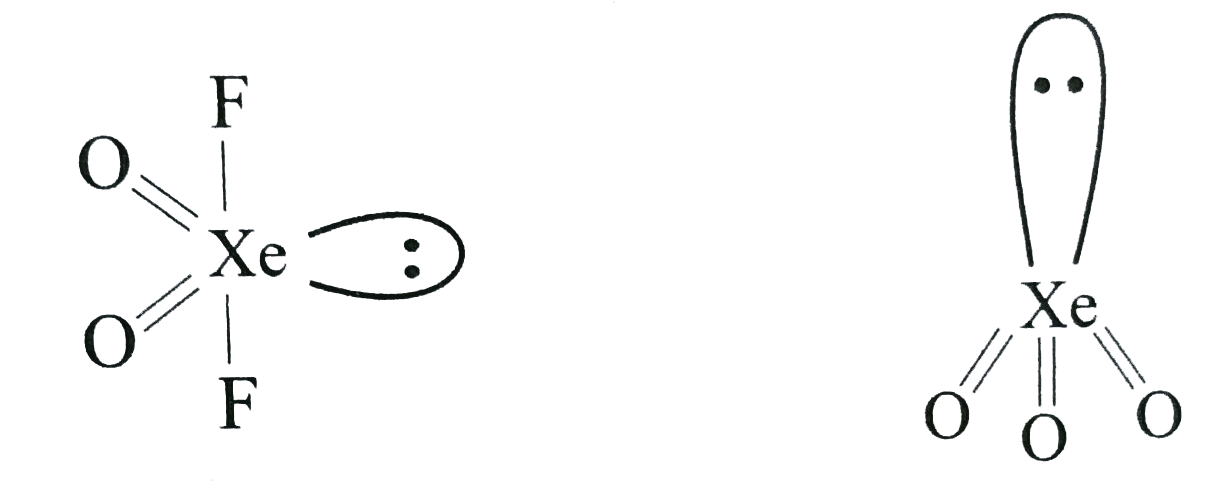Out of (i)XeO3(ii)XeO2F2 and (iii)XeO4, the molecules having same number of lone pairs are
(i) and (ii)
(ii) and (iii)
(i) and (iii)
None of these
The correct Answer is:A
XeO3 and XeO2F2 have 1 lone pair for structure

Topper's Solved these Questions
- BOOK - A2ZCHAPTER - P BLOCK ELEMENTS ( GROUP 15,16,17,18)EXERCISE - Section B - Assertion Reasoning35videos
P BLOCK ELEMENTS ( GROUP 15,16,17,18)
- BOOK - A2ZCHAPTER - P BLOCK ELEMENTS ( GROUP 15,16,17,18)EXERCISE - AIPMT/NEET Questions71videos
P BLOCK ELEMENTS ( GROUP 15,16,17,18)
- BOOK - A2ZCHAPTER - P BLOCK ELEMENTS ( GROUP 15,16,17,18)EXERCISE - Oxides, Oxoacids, Polyhalides Ions, Pseudohalides And Interhalogen Compounds26videos
P BLOCK ELEMENTS ( GROUP 15,16,17,18)
- BOOK - A2ZCHAPTER - ORGANIC COMPOUNDS CONTAINING NITROGENEXERCISE - Section D - Chapter End Test30videos
ORGANIC COMPOUNDS CONTAINING NITROGEN
- BOOK - A2ZCHAPTER - SOLID STATEEXERCISE - Section D - Chapter End Test30videos
SOLID STATE
Similar Questions
Knowledge Check
- Question 1 - Select One
Out of (i) XeO3(ii)XeOF4and(iii)XeF6 the molecules having same number of lone pairs on Xe are
A(i) and (ii) onlyB(i) and (iii) onlyC(ii) and (iii) onlyD(i),(ii) and (ii) only - Question 2 - Select One
Out of (i) XeO3(ii)XeOF4and(iii)XeF6 the molecules having same number of lone pairs on Xe are
A(i) and (ii) onlyB(i)and (iii) onlyC(ii) and (iii) onlyD(i),(ii) and (iii) - Question 3 - Select One
Among the following molecules
(i)XeO3(ii)XeOF4(iii)XeF6
those having same number of lone pairs on Xe areA(i) and (ii) onlyB(i) and (iii) onlyC(ii) and (iii) onlyD(i), (ii) and (iii)
Among the following molecules, (i)XeO3(ii)XeOF4(iii)XeF6 those having same number of lone pairs on Xe are:
View SolutionAmong the following molecule
(i)XeO3(ii)XeOF4(iii)XeF6
Those having same number of lone pairs on Xe areView SolutionAmong the following molecules
(i) XeO3 (ii)XeOF4 (iii)XeF6
Those having same number of lone pairs on Xe areView SolutionThe approximate shape of a molecule can often be predicted by using what is called the valence-shell electron-pair repulsion (VSEPR) model. Electrons in bonds and in lone pairs can be thought of a ''charge cloud'' that repel one another nad stay as far apart as possible, thus causing molecules to assume specific shapes.
The repulsive interactions of electron pairs decrease in the order:
Lone pair - Lone pair gt Lone pair - Bond pair gt Bond pair - Bond pair
These repulsive effects result in deviations from idealised shapes and alteration in bond angles in molecules.
Among the following molecules.
(P) XeO3 (Q)XeOF4
(R) XeO2F2 (S)XeF5
Those having different molecular geometry but same number of lone pairs on Xe are :View SolutionThe shape of XeO3 molecule is
View Solution

